Menu
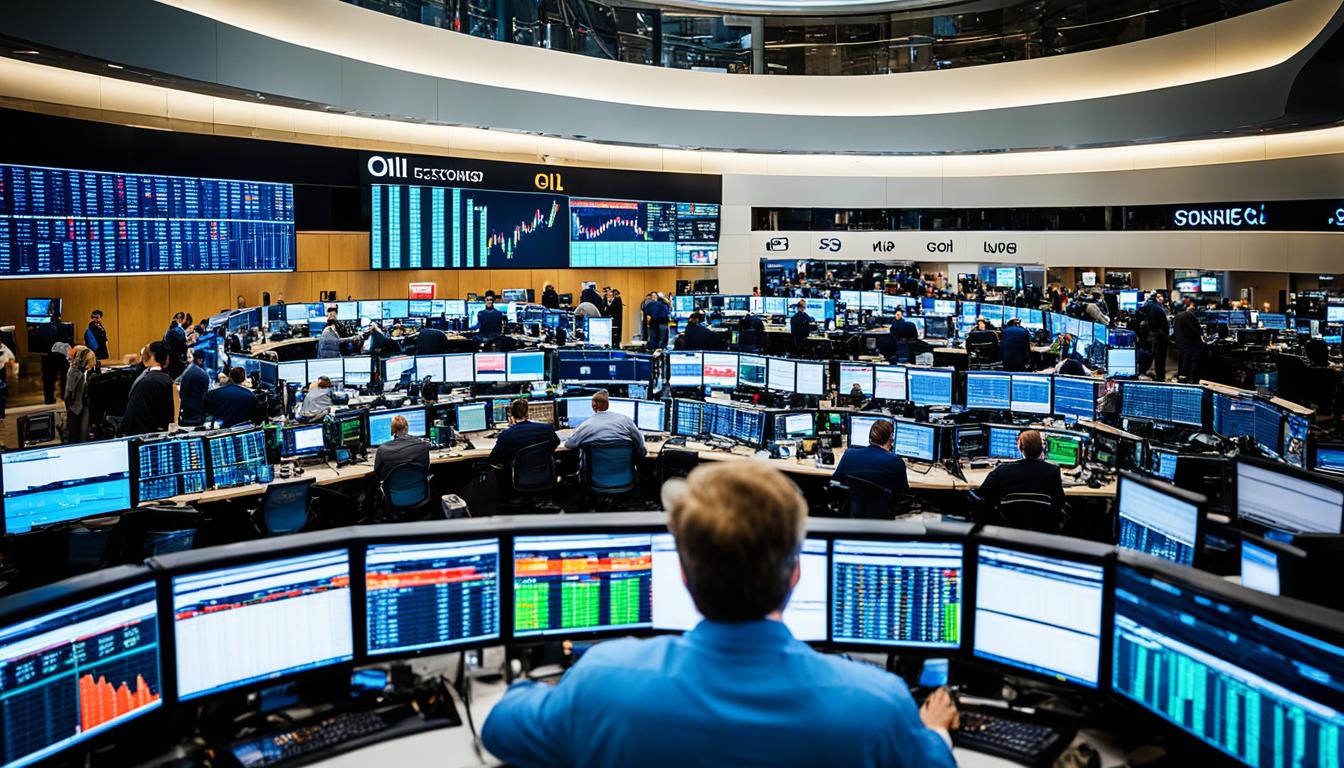
Did you know that bad weather in key farming areas has cut crop yields? This has led to possible shortages in basic foods like wheat and corn. At the same time, troubles in the Middle East have made oil more expensive. So, the world’s markets for goods are facing serious challenges.
Also, there’s news that manufacturing is slowing down globally. This has made metal prices drop. But, the signals show that the price of gold might go up. To do well in this market, you need to understand these changes. This way, you can spot new trends early.
Studying the global markets for things like food, metals, and oil needs a careful eye. You should look at how much is made, how much is wanted, and what’s happening in the world. By knowing these things, you can make smarter choices when you trade. This can also help you avoid some risks.
If your goal is to earn more money, special services for these markets can be really helpful. Today, the market can change quickly. To keep up, it’s important to look at both basic facts and the more detailed numbers. This mix is key to staying ahead in the market.
The global commodity markets are huge and very complex, they play a key role in the world economy. They cover the trade of raw materials and basic farm products. These are split into hard (like metals and energy) and soft (such as grains and livestock) commodities. Knowing how the international commodity exchange works is vital to see the whole economic picture.
The use of commodities has greatly increased, thanks to more people and higher incomes. The market includes various products, from metals to food. This growth is helped by new technologies, which make materials more versatile and let us change them for other goods. These markets affect prices, reasons behind those prices, and have big economic impacts, especially on new and developing economies.
Commodity trading is crucial because it sets world commodity prices and impacts economies worldwide. Different countries see different demand for commodities, based on how developed they are. Responding to economic changes in these markets has actually helped keep things stable. The history of commodities like energy, metals, and agriculture shows how vital they are to many countries’ economies.
| Commodity Type | Examples | Impact on Economy |
|---|---|---|
| Hard Commodities | Metals, Energy Resources | Influences industrialisation, infrastructure development |
| Soft Commodities | Grains, Livestock | Essential for food security and agricultural stability |
The book “Commodity Markets: Evolution Challenges and Policies” highlights big events like COVID-19 and the Ukraine war’s effects. It’s a key guide with 180 pages, offering insights into global commodity markets and their dynamics.
Getting the hang of commodity market dynamics is key for any sharp investor. Commodities are split into hard and soft categories. This helps us understand their market behaviours and risks. It is crucial for making smart investment moves.
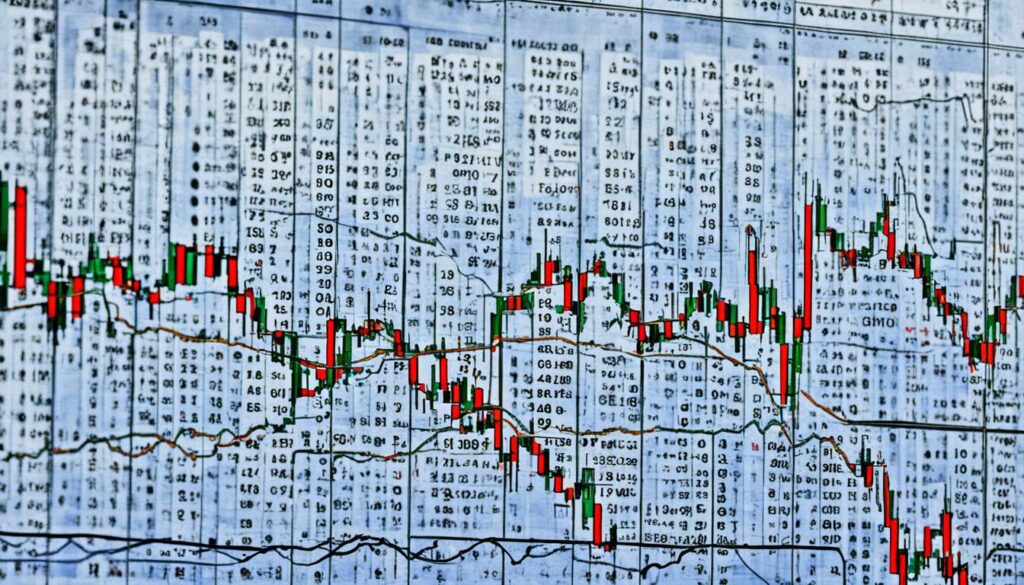
Hard commodities are things like gold, rubber, and oil. They are things we take directly from the earth. Their prices are mostly influenced by how much we dig up, world events, and rising prices. Because they are actual things, you need to think about how to store and move them around. This adds extra complexity to dealing in these markets.
Soft commodities refer to farm products like corn, wheat, and coffee. These markets are highly affected by the weather, how much we harvest, and the time of year. They are key for us to eat, which makes trading them at places like ICE Futures U.S., CBOT, CME, and NYMEX very important.
It’s important to know what affects commodity prices in the world market. Things like supply and demand, world events, and signs in the economy all play a big part. They help us understand how markets move and what could happen next.
The balance between how much is available and how much people want is key. If there’s too much or too little, the prices change. For example, when butter was needed more but there wasn’t enough, its price went up in the US.
Global trades also make a big impact. If there are sudden changes in deals between countries, prices can become unpredictable. The Russia-Ukraine conflict in 2022 caused trouble for the world’s trading of wheat and oil. This made prices jump up and down.
World political issues can cause big changes in prices. For example, challenges between countries can stop the flow of goods. This happened when sanctions were put on Venezuela’s oil sales. Also, unexpected events like the Coronavirus pandemic reduced oil prices heavily in 2020. This was because people travelled less and didn’t need as much fuel.
Things like a country’s economic growth, the prices of goods, and how many things are being made can tell us if commodity prices will go up or down. When the economy is strong, people want more goods. This includes things like metals and energy. When the economy slows down, less is wanted and prices can fall. The value of the US dollar also has a big say in prices worldwide.
Weather is another big factor. Bad weather can harm crops, making food more expensive. In Brazil, bad weather increased the cost of coffee and corn. By watching the weather, import-export trends, and supply-demand balances, we can better predict market changes.
| Factor | Impact on Commodity Prices | Example |
|---|---|---|
| Supply-Demand Dynamics | Price increases with high demand, price drops with oversupply | US Butter prices in September 2023 |
| Geopolitical Events | Disruptions lead to price volatility | Russia-Ukraine war & Oil prices |
| Economic Indicators | GDP growth affects demand for commodities | WTI oil price in April 2020 |
| Weather Conditions | Impact on agricultural output | Brazil coffee and corn prices in April 2021 |
The link between supply and demand drives world commodity prices. Weather, crop yields, and the need for goods affect these prices. Getting details about these factors helps in understanding market trends better.
Weather plays a big role in how much we grow. Natural disasters like droughts or floods can lower crop yields. This causes fewer supplies and prices to go up worldwide. “Navigating Global Commodity Markets with Insight” shows how weather, plus more people and money, has made us use more goods since the last century.
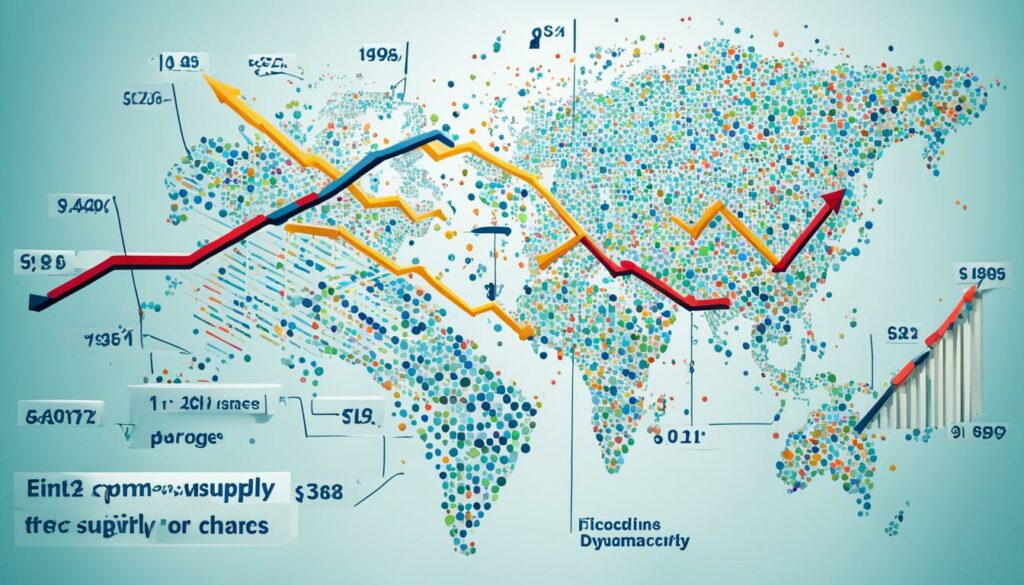
The need for goods by industries also sets market trends. Metals and energy prices are often linked to what industries need. When manufacturing and building need more metal, prices can rise. The study points out that different economies affect commodity prices in various ways.
| Commodity Group | Examples | Impact on World Commodity Prices |
|---|---|---|
| Agricultural | Wheat, Corn | Highly susceptible to weather conditions; price spikes during adverse climatic events. |
| Energy | Crude Oil, Natural Gas | Industrial demand fluctuations and geopolitical tensions influence pricing. |
| Metals | Gold, Copper | Influenced by technological advancements and industrial applications. |
The study also looks at how countries respond to economic ups and downs. Certain financial actions help protect against global market risks, especially in tough times like the COVID-19 pandemic. Strategies like these lessen the effects of crises.
The world of commodity trading has changed a lot because of geopolitical events. The conflict between Russia and Ukraine, starting on February 24, 2022, affected the trading of goods worldwide. This crisis has been a big deal for commodity markets.
The Middle East often plays a key role in global oil markets. Tensions there can lead to oil supply problems, making prices swing. The crisis in Ukraine has made this even worse, affecting the prices of natural gas and oil especially. This turmoil also makes the markets for items like oil and gold very unpredictable.
Trade fights and sanctions are also big players in commodity markets. For example, putting sanctions on Russia has messed with supply chains, changing prices on many goods like oil, gas, and wheat. A study showed a 52.90% connection between how different items affect each other’s prices. This shows how serious political problems can make trading goods harder and more risky.
An overview of current market conditions reveals:
| Commodity | Impact of Geopolitical Events |
|---|---|
| Crude Oil | Highly sensitive to Middle East tensions leading to price spikes |
| Natural Gas | Disrupted supply chains due to sanctions and trade disputes |
| Wheat | Price volatility due to conflict in major producing regions |
| Gold | Traditionally a safe haven during geopolitical uncertainty |
Geopolitical events really shake up the world of commodities. It pays to keep an eye on world events for smart trading choices.
It’s key to grasp how economic indicators work in commodity trading. They help us predict the market and make smart choices. Indicators like GDP, inflation, and industrial production levels give us clues on the market’s health. They greatly affect how we understand and predict the commodity market.

High GDP growth tells us a country is doing well. This means people are spending more and industries are busy. So, they need more commodities. But if GDP growth slows, so does the need for commodities, lowering their prices.
Watching inflation is important as it can increase commodity prices. Rising prices reduce the worth of money, which leads banks to tweak interest rates. These changes influence how much it costs to borrow money, affecting the economy and commodity markets.
The levels of industrial production show how well manufacturing is doing. This is tied to the demand for commodities such as metals and energy. More industrial activity means a higher need for raw materials, which can raise commodity prices. Keeping an eye on this helps in making better forecasts and setting trading plans.
| Indicator | Impact on Commodity Prices | Trading Strategy |
|---|---|---|
| GDP Growth | Increase in commodity demand and prices | Long positions in growth-oriented commodities |
| Inflation Rates | Potential rise in commodity prices | Hedge against inflation with commodities |
| Industrial Production | Boost in demand for industrial commodities | Invest in industrial metals and energy |
In the world of commodity market trends, technical analysis is key for traders. This method looks at past price movements to predict the future. It helps to find trends and make smarter trading choices.
Patterns like head and shoulders and trends lines are important in technical analysis. They let traders guess where prices might go by studying the past. Charting methods, such as bar charts and moving averages, help traders see the market’s movements better.
Moving averages help smooth out the market’s ups and downs. They’re calculated over different time periods depending on what chart is being looked at. Trend lines, on the other hand, show possible changes in a trend when prices cross them. These tools make the market clearer and help traders choose based on real data.
| Chart Pattern | Description |
|---|---|
| Head and Shoulders | Identifies a trend reversal, indicating a bullish-to-bearish market shift. |
| Double Tops and Bottoms | Signals potential price direction changes following two successive highs or lows. |
| Trend Lines | Represents support and resistance levels by connecting price highs and lows. |
Indicators like MACD and RSI are vital in market analysis. MACD follows trends and RSI shows market conditions. They are used to find either good buying or selling opportunities.
Momentum indicators, including Stochastic and Bollinger Bands®, check market volatility. They aim to help traders buy at low prices and sell at high ones. These indicators give deeper insights into the market, improving trading strategies.
Andre Murphy explains that technical analysis studies market charts to predict future trends. It’s based on three main ideas: the market considers everything, prices follow trends, and history repeats. By using technical analysis, traders can understand the market dynamics better and make smarter choices.
It’s important to know the basics of commodities markets and exchanges for global trade. These places let people buy and sell commodities. They are also key in setting global commodity prices.
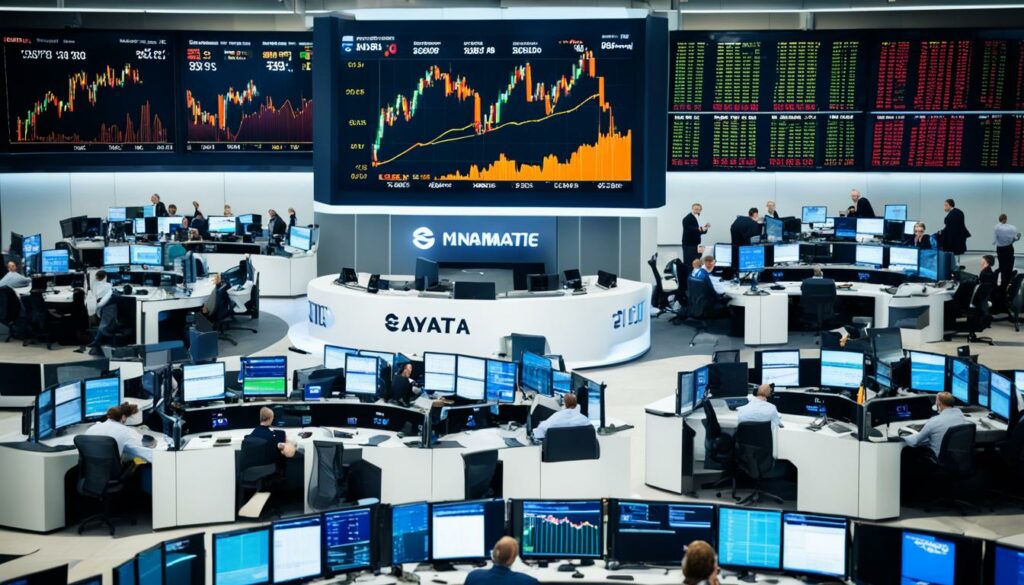
The Chicago Board of Trade (CBOT) started in 1848. It brought grain futures to a wider market. This idea then spread to other exchanges, including those for cotton and livestock.
Today, CBOT still influences world commodity prices a lot.
The London Metal Exchange (LME) leads in trading industrial metals globally. It was set up in 1877. Over the years, it has become the main spot for metals like aluminium, copper, and zinc.
The way LME prices these metals is at the heart of worldwide commodity prices for them.
The New York Mercantile Exchange (NYMEX) deals with things like crude oil, gold, and natural gas. It’s been vital in global trading due to its wide range of commodities and high trading activity.
NYMEX sets key benchmarks and helps shape global commodity prices for energy and precious metals. It’s crucial for trading strategies and risk management.
In the global commodity markets, using different trading strategies is key. These strategies range from basic analysis to complex technical methods. They can help you make more money and lower risks.
In volatile markets, like oil and commodities, news trading is a good strategy. Traders use this by quickly reviewing news and market expectations. This helps them make smart choices when big economic news hits the global commodity markets.
For those who want to avoid overnight risks, end-of-day trading strategies are very useful. By looking at how prices moved the day before, traders can stay away from the night’s market swings. Swing trading is another option, for those who want to use market changes to make money. It requires a lot of study into technical analysis and chart patterns, allowing for both short and long positions.
Day trading is for those who like to be active during market hours but want to avoid overnight risks. These trades last from 1 to 4 hours and offer lots of freedom. Trend trading, on the other hand, focuses on market trends. It uses technical analysis to keep in line with the market movement.
Commodity trading helps diversify and protect against inflation losses. This trading includes assets like gold, oil, natural gas, and copper. Traders use different financial tools such as stocks, futures, options, ETFs, and CFDs. They follow market trends with the help of indicators like moving averages.
| Trading Strategy | Key Advantages | Suitable Commodities |
|---|---|---|
| News Trading | Quick Market Reaction | Oil, Metals |
| End-of-Day Trading | Minimising Overnight Risk | Gold, Grain |
| Swing Trading | Opportunities in Fluctuating Markets | Natural Gas, Copper |
| Day Trading | Flexibility | Energy, Agricultural Products |
| Trend Trading | Following Market Trends | Metals, Energy |
Range trading aims to buy low and sell high in sideways markets. It works well with fundamental trading. Fundamental trading uses events like supply changes to make decisions. Breakout trading is about buying or selling when prices break through support levels. Spread trading makes money from price differences between related commodities.
One powerful but less common strategy is specialising in trading just one commodity. This deep focus can lead to better trading opportunities. Position trading, which involves holding trades for longer, pairs up nicely with season trading. Season trading takes advantage of predictable commodity price changes for profit.
The mix of trading strategies in global commodity markets highlights the need for a complete approach. By using a blend of strategies for specific situations, traders can do better in commodity markets and earn more.
In commodity trading, it’s key to handle risks well. Global markets can change fast. So, about 200 experts work hard to manage these risks carefully. This is especially important as market trends can be very unpredictable, often changing due to world events or problems in supply chains. To protect against sudden price changes, it’s vital to have strong plans in place. This can help businesses deal with price changes that can be as high as 70% in some areas.
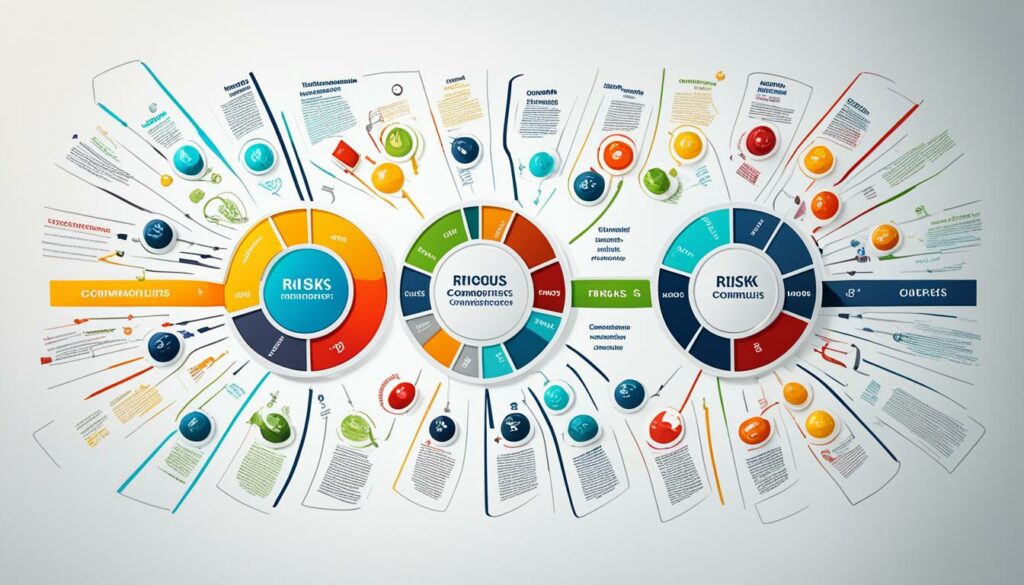
Hedging, or protecting against possible losses from price changes, is crucial. It involves fixing prices with different financial tools. This way, traders in the commodity market can feel more certain. Hedging is a widely used method in many areas like energy, farming, and manufacturing. It can help stabilise costs and meet rules about reporting and being sustainable.
Futures and options are key tools in managing price risks. They let traders choose prices or the right to buy or sell later on. This becomes very important as the market and rules become more complex. In this changing world, making timely and accurate risk reports is a must. It helps in making smart decisions in such times.
There isn’t a one-size-fits-all way to manage risk in commodity trading. Goals and the reasons behind them can vary a lot between companies. Still, using methods like hedging and futures and options is very common. These approaches help in dealing with the ups and downs of the market. Traders are encouraged to use a mix of methods to stay strong against sudden changes.
Global trade in commodities is the foundation of our world’s economy. Oil markets show how external influences can shake global trade. To understand these dynamics, you need to know about geopolitics and economic rules.
Oil’s high demand and the Middle East’s complex politics highlight global trades shifts. Exchange markets like the Chicago Mercantile Exchange and the New York Mercantile Exchange mediate trades. Any supply problems in oil instantly change its prices worldwide.
The Middle East’s issues can make oil prices spike very quickly. These events force smart trading moves to be made. Because oil’s price affects the whole world, it changes costs in transport and industry goods.
The rules for commodity trading, like the U.S. Commodity Exchange Act of 1936, have shaped today’s market. By creating the Commodity Futures Trading Commission in 1974, these rules now cover more types of trading. This shows how complex trading in commodities, especially oil, can be.
About two-thirds of Emerging Market and Developing Economies depend a lot on commodities. For them, oil prices changing doesn’t just impact their economy. It also affects global trade, showing how important commodities are.
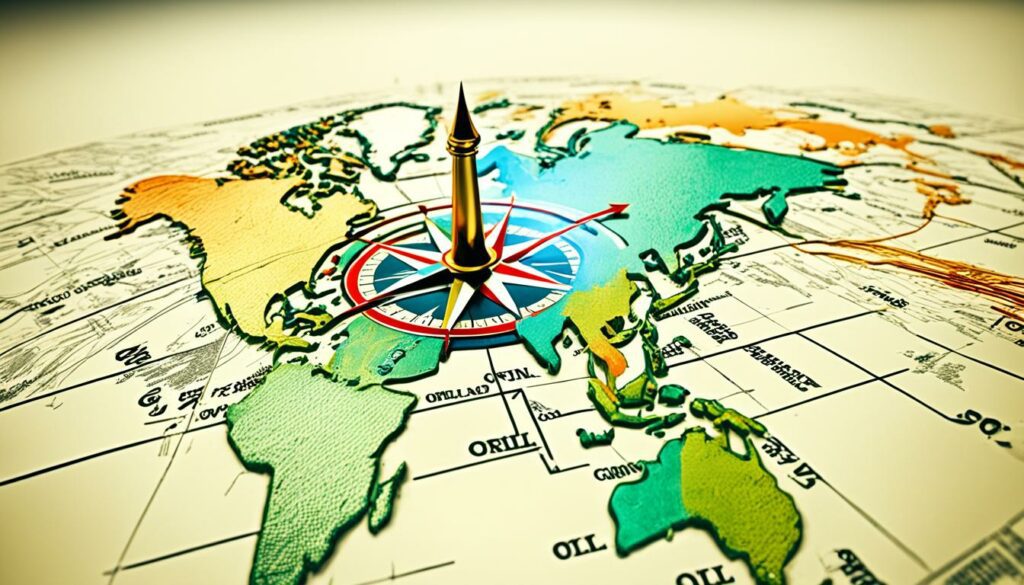
Looking at global commodity markets helps traders choose their strategies wisely. Energy prices are set to fall by 3 percent in 2024. They will then drop by another 4 percent in 2025. These changes have a big impact on the whole market.
Recently, commodity prices have been getting lower. In the first quarter of 2024, they dropped by 3 percent. The major reason was the fall in energy prices. In 2024, experts guess Brent crude oil will be around US$84. Next year, it’s expected to drop to US$79.
In the first 2024 quarter, natural gas prices plummeted by 40 percent. Yet, Japan’s LNG benchmark went up by 4 percent in the same time.
Food prices in commodities dropped by 4 percent in the start of 2024. But at the beginning of April, cocoa and Robusta coffee prices rose a lot. Despite this, agriculture prices are set to drop more in 2024 and 2025 due to better supply. Industrial metals, however, should hold steady in 2024 then see a small growth in 2025.
To get through the complexity of global markets, using advanced forecasting is key. Mixing historical data with predictive analysis helps make sense of future trends. This blend explains the predicted metal prices’ stability in 2024 and a slight rise in 2025. It’s due to economy strength and supply chain changes.
Different commodities need different forecasting approaches. The energy market is facing big risks from geopolitical issues like conflicts and security crises. So, detailed geopolitical risk assessments are needed for good predictions. They provide a roadmap for trades in the market.
There’s also the coming price moderation in food commodities by 2024. Professionals use a mix of numbers and insights for a complete picture. This makes for more accurate market forecasts.
To understand commodity markets well, we need strong tools. These tools look at both the basics and the details to show us market movements and changes.
Fundamental analysis looks at the true worth of items by checking out the economics behind them. It looks at things like:
Good places to start for the basics include:
| Source | Description |
|---|---|
| USDA Economic Research Service | Offers data on agricultural commodities with regular updates. |
| OPEC Monthly Oil Market Report | Provides specialised insights into the oil sector. |
| World Bank’s Commodities Price Data | Offers global price data on various commodities. |
Fundamental tools help traders understand the market. They help with the various parts of the supply chain.
Technical analysis uses past prices and trends to guess future ones. It includes things like:
The best places for technical analysis are:
| Platform | Features |
|---|---|
| Bloomberg | Comprehensive view of commodity markets with real-time updates. |
| Reuters | Timely news, commodity prices, and market analytics. |
| Trading Economics | Covers 20 million economic indicators from 196 countries. |
| CME Group | Trading platform for futures and options, including commodities. |
Putting both kinds of analysis together makes market tools work even better. This way, traders can predict the market well, reducing risks.
In commodity markets, key players and rules have a huge impact. They set up the base and rules for the market. This is crucial for a stable and fair market.

Traders, investors, and speculators all have unique roles in the markets. They help set prices on the international commodity exchange. Traders work for short-term gains or to reduce risks. Investors use commodities to protect against inflation or as part of a long-term plan. Speculators provide trading volume. Although they can make prices change quickly, they also keep the markets active, as seen in the 1973 spike in futures prices.
Important U.S. exchanges for these activities include ICE Futures U.S., CBOT, CME, and NYMEX. They allow trading of physical goods and futures, as defined by the CEA since 1936. For example, CBOT has been key for making grain futures trading consistent since 1848.
Rules are crucial for keeping the market fair and free from manipulation. The CFTC, created in 1974, looks after the sector. It started with oversight on farm goods but now also manages financial products and complex investments.
The CFTC has different parts, like the DMO, which oversees trading of these special contracts. The DMO looks after the markets, checks the law, checks new market products, and helps keep an eye on market health. This keeps the market in order.
Other important regulators include the SEC, which handles stocks and bonds. There’s a debate about how to classify cryptocurrencies – as goods or investments? The SEC sees most cryptos as investments. This affects the approval of bitcoin-related investments and changes how we trade these digital assets.Also, FINRA and NFA help by supervising dealers and regulating parts of the market on their own.
| Regulator | Key Role | Market Focus |
|---|---|---|
| Commodity Futures Trading Commission (CFTC) | Regulating derivatives markets | Futures, options, and swaps |
| U.S. Securities and Exchange Commission (SEC) | Overseeing equity and bond markets | Stocks and securities |
| Financial Industry Regulatory Authority (FINRA) | Overseeing broker-dealers | Equities and securities |
| National Futures Association (NFA) | Self-regulation of derivatives | Futures and options |
To understand and deal with global commodity markets, we need to know many things. Prices of Brent crude oil fell sharply in late 2014 to about $60 per barrel. They had been as high as $100-$120.
This drop reminds us that markets can change quickly. Between 2009 and 2011, things seemed calm. But this calm was just a phase. It showed that global commodity markets are always changing and risky.
Guessing where prices will go long-term, especially in oil, is hard. But by understanding the key players, like importing and exporting countries, you can predict better. Knowing how these forces differ and work against each other helps traders make good choices.
In closing, success in global commodity markets needs careful planning. It means knowing what affects market trends and using solid data for decisions. This way, people in the market can avoid big risks and find opportunities for growth.
Global commodity markets are places where essential raw materials and farm products are bought and sold. This includes things like metals, energy resources, grains, and animals.
They are key to setting prices and economic health worldwide. They affect energy and food costs for everyone from home cooks to big companies.
Hard commodities need mining or extracting, like gold and oil. Soft commodities are farm products or animals, such as wheat and coffee beans.
Prices are influenced by how much is wanted versus how much is available. Events like bad weather, changing demands, and politics can change prices.
The balance between supply and demand sets prices. If there’s not enough of something, the prices go up. Or if demand falls, prices can drop.
Yes, big political events can change prices a lot. Problems in the Middle East often lead to higher oil prices, for example. And trade issues can also shake up the markets.
They show how the economy is doing and what people are buying. Knowing these helps traders see where the markets might go and make smart choices.
It uses charts and past prices to predict what might happen next. This way, traders can try to figure out the best times to buy or sell.
Important places include the Chicago Board of Trade, the London Metal Exchange, and the New York Mercantile Exchange. They are where traders go to buy and sell, helping set prices.
Good strategies look at both the basics and technical parts of the market. They also use hedging to lessen risks, and futures or options to make trades.
Hedging is about reducing the impact of price changes. By using futures and options, traders can protect themselves from major losses in volatile markets.
Middle East tensions often lead to higher oil prices. This also creates buying and selling opportunities for traders to manage the risks and benefits.
Paying attention to recent trends and using good forecasting can help traders guess what the market will do next. This relies on looking at data and making predictions.
The big tools are fundamental and technical analysis. One looks at the economy, the other at past prices, to guess what will happen with prices in the future.
Traders, investors, and regulators are the main players. Traders aim to buy and sell for profit, investors want to grow their money, and regulators keep the markets fair and stable.